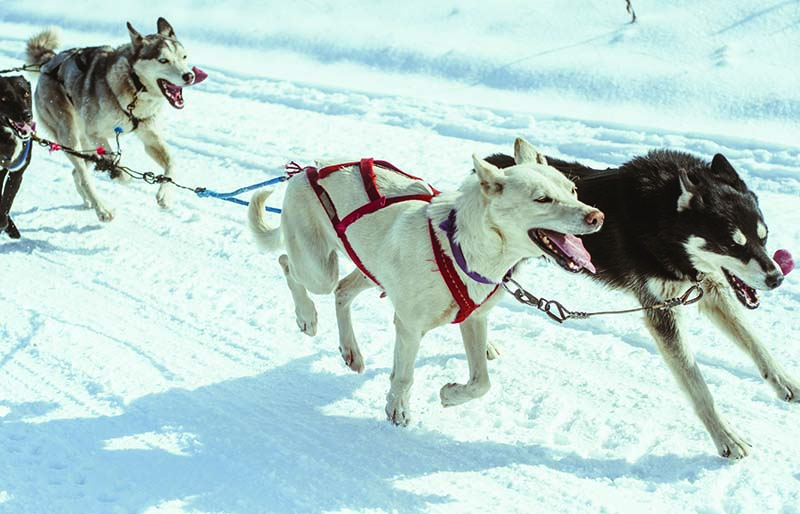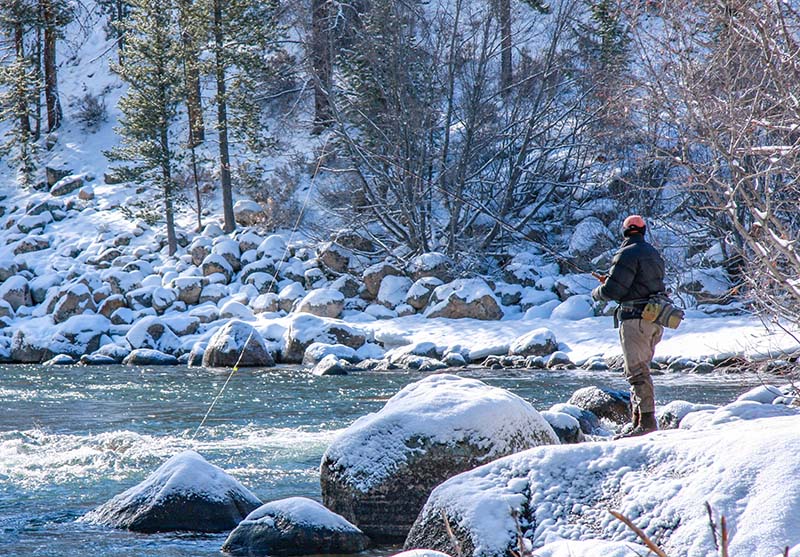Whether you’re an adrenaline junkie or crave a one-of-a-kind experience, northern Utah and Park City has some of the most epic adventures around. Follow our local writers as they explore three of the most popular.
HELI-SKIING BY AMBER QALAGARI
Powderbird
Powderbird.com
Nate Rothe is a lead guide and director of operations at Powderbird. His guiding career has taken him from the slopes of Colorado to the Andes before he came to guide in Utah. Th is year marks his ninth season at Powderbird and we don’t expect he’ll leave anytime soon, for as he says, “the snow here is unmatched.”
4:30 PM: My day begins the night before I guide, when I put together the operations plan for tomorrow’s excursion. I start with our reservations staff who gives me the low down on who I’ll be guiding: a group of six skiers with varying abilities and home states, all about to share their first heli-skiing experience together. Next, we staff up: Logan Cookler will take group one and I will take group two, Pat McDermott is on forecasting duty and the Powderbird chef will be cooking up something tasty. When we are aligned, it’s time to sleep—tomorrow is going to be an epic day.
7:00 AM: We revisit the plan in our morning huddle, making sure we know our roles. To off er the safest, most enjoyable experience we must work seamlessly together. Th e clients arrive as the Powderbird chef brings out the full spread: bacon, eggs and a wide array of fresh baked goods. I share a bite with Joe from Seattle and Julie from Sweden—both have never been to Utah but have been dreaming of this day for years. Th e stoke level in the room is high and I am crossing my fingers we’ll get the green light to fly.
Over in the forecast department, Pat is pulling weather, avalanche data and conditions for the day using a variety of sources. Pat compares them to our own observations and measurements of snowpack, weak layers, and visibility. If we can’t fly today, I’ve got a solid plan in my back pocket. I’ll guide our clients through only the best terrain at Snowbird, a world class resort a stone’s throw from our lodge. If I can’t give them heli-skiing, at least I can still deliver some serious powder.
“We’re clear for flight,” our pilot Angela confirms with me. Giddy with excitement we strap on our boots a little faster.
After a thorough safety orientation where we ensure each guest knows what is expected in various scenarios, I pass out airbags equipped with beacons, shovels and probes.
The anticipation is thick in the air but we have one last thing to do before we set off: aircraft orientation. I walk through FAA guidelines and regulations on passenger safety, unloading and loading procedures and what to do in an emergency.
Equipment? Check.
Game plan? Check.
Excitement level? Th rough the roof. We’re ready to fly!
9:00 AM: I’ve mapped out the first run, it’ll be an easier ride through six inches of pure powder. I want to make sure my group warms up their ski legs. We’re nearing drop off and I can see Julie’s anxiety is amping up. “Take a deep breath and look at where we are,” I tell her. Her nerves ease as we take in the 360-degree views of the Wasatch Mountains. After nine years of guiding here, these peaks still leave me speechless.
We descend into a wide-open bowl of untouched powder, my skis practically kiss the snow. Nervous looks have been replaced with thick grins, shouts of pure glee reverberate off the mountains as we float down together. This magical feeling is what I live for, it’s like I’m surfing on snow. I can tell my guests are feeling it too.
Angela picks us up in the helicopter and we’re off to find some trees for our next run—a request from Joe. Run three we tackle a tight chute—my favorite on the west side. Run four is all about playtime as we carve through another big open bowl. Run fi ve is for Liz, she’s aft er speed and I know just the route. Run six is a crowd-pleaser, a ridge line that drops us through nicely spaced trees.
Run seven, our final run. It’s the first time this group has broken their smiles, I too don’t want this day to end! Aft er one last celebratory run through winter paradise we board the helicopter and head to the lodge, each of us with sore legs and full spirits.
3:00 PM: Our time in the air may have ended but the après celebration commences! Our in-house chef has outdone himself again with Thai Curry. We share beers and tales from today’s adventure, and I can tell with this group, we’ll be skiing together again next year.
4:30 PM: Our staff regroups to talk about the day, discussing wins, improvements and pertinent snow observations. I use this to craft my operations plan for tomorrow—it’ll be another epic day in the best snow on earth.
 DOG SLEDDING – BY AIMEE COOK
DOG SLEDDING – BY AIMEE COOK
Rancho Luna Lobos
lunalobos.com
Dog sledding is a winter sport that has been around for centuries, but what does a dog need to be able to participate? The answer: heart, purpose and a connection to their musher. For the past 13 years, Rancho Luna Lobos has been winning races, showing their guests a good time with tours, and educating the public. Co-owner, Fernando Ramirez has been dog sledding since childhood and is currently ranked 12th in the world; his love for the dogs is palpable.
“Every dog has a voice and a story to tell and it is our job, to the best of our ability, to really listen to and learn what they want to teach us,” states co-owner, Dana Ramirez.
The 83 dogs currently living on the 55-acre Rancho Luna Lobos do not have pedigrees, most are surrenders, and some come to the ranch emotionally damaged, some even with physical limitations. Fernando’s dogs are a representation of what it means to be both man and animal. The dogs respond to him with gusto, determination and pure grit. Dog sledding is great therapy for dogs, but when some just prefer to be a ranch dog, they are accepted as such. The Ramirezes call themselves “dog listeners”.
Being a dog lover, even I was surprised and unprepared for the emotional response from my experience at Rancho Luna Lobos. When you visit the ranch, you witness first-hand the dogs, the owners and the space, all in sync. They’re on a mission to give every dog that enters their life a purpose and to bring awareness to the dog sledding industry.
With the Rancho Luna Lobos dog sledding packages not only do you experience a thrilling rush through the mushing course, you also take turns driving the dog sled. The tour is truly authentic and quite a work-out. Expect to walk, hike and push during portions of the trail. The adventure lasts from 90 minutes to 120 minutes and includes the ride, a kennel tour, presentation and play time with the dogs.
If you are looking for a dog sledding outing where you sit and the dogs do all the work, you will want to look somewhere else. However, if you crave excitement, exercise and canine bonding, Rancho Luna Lobos is the adventure for you. FLY FISHING BY JULIE HOOKER
FLY FISHING BY JULIE HOOKER
Fish Heads Fly Shop
fishheadsflyshop.com
Whether wading in a mountain stream or standing waist-deep in the ocean waves, casting a line builds an appreciation and connection to the natural world unlike any other sport. Winter in Utah presents the ideal time to get hooked on fly fishing. As a novice angler, I wandered into Fish Heads Fly Shop, minutes away from the Provo River in Heber, to meet their guides and check out equipment. I asked, “Why do you like saltwater fishing?” Ben Diamond, owner of the shop enthusiastically replied, “It’s an adrenaline rush to have a 140-pound fish on the end of your line.” I imagine he’s right!
“February is my favorite time to fish the Provo,” Diamond further explains. “It is the best dry fly-fishing time of the year because of the buffalo midge fly hatch.” With the right guide, 80-100 fish will pop up on the Provo River ready to take the bait. (I can’t wait!)
Fish Heads features all the equipment necessary for everyone from the novice to the experienced angler. It turns out that once an angler learns to cast, they can cast in both freshwater and saltwater, and make the transition from trout to bone fish.
Dry fly fishing is credited with putting the sport on the map—laying down a fly on clear water, watching and feeling the fish strike easily fuels a fly-fishing addiction. Dry fly fishing is best in the mornings and evenings when the fish feed on the surface and the flies are hatching.
Fly fishing is not only captivating, but versatile and Fish Heads Fly Shop guides anglers all winter long.
Like with any winter sport, proper layering is essential. Fish Heads Fly Shop stocks everything from wool socks to waders and polarized glasses to gloves. They even stock waders for women.
Whether you are shopping for gear for a planned destination saltwater trip, local fishing, or the perfect gift for the angler in your life, Fish Heads Fly Shop has everything you need along with experienced guides to support you in the sport















